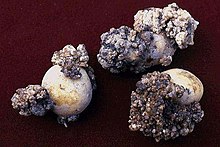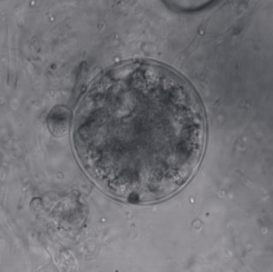
Chytridiomycota are a division of zoosporic organisms in the kingdom Fungi, informally known as chytrids. The name is derived from the Ancient Greek χυτρίδιον, meaning "little pot", describing the structure containing unreleased zoospores. Chytrids are one of the earliest diverging fungal lineages, and their membership in kingdom Fungi is demonstrated with chitin cell walls, a posterior whiplash flagellum, absorptive nutrition, use of glycogen as an energy storage compound, and synthesis of lysine by the α-amino adipic acid (AAA) pathway.

The Mucorales is the largest and best-studied order of zygomycete fungi. Members of this order are sometimes called pin molds. The term mucormycosis is now preferred for infections caused by molds belonging to the order Mucorales.
Phytophthora sojae is an oomycete and a soil-borne plant pathogen that causes stem and root rot of soybean. This is a prevalent disease in most soybean growing regions, and a major cause of crop loss. In wet conditions the pathogen produces zoospores that move in water and are attracted to soybean roots. Zoospores can attach to roots, germinate, and infect the plant tissues. Diseased roots develop lesions that may spread up the stem and eventually kill the entire plant. Phytophthora sojae also produces oospores that can remain dormant in the soil over the winter, or longer, and germinate when conditions are favourable. Oospores may also be spread by animals or machinery.

Phytophthora palmivora is an oomycete that causes bud-rot of palms, fruit-rot or kole-roga of coconut and areca nut. These are among the most serious diseases caused by fungi and moulds in South India. It occurs almost every year in Malnad, Mysore, North & South Kanara, Malabar and other areas. Similar diseases of palms are also known to occur in Sri Lanka, Mauritius, and Sumatra. The causative organism was first identified as P. palmivora by Edwin John Butler in 1917.
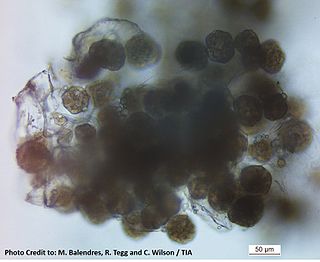
Powdery scab is a disease of potato tubers. It is caused by the cercozoan Spongospora subterranea f. sp. subterranea and is widespread in potato growing countries. Symptoms of powdery scab include small lesions in the early stages of the disease, progressing to raised pustules containing a powdery mass. These can eventually rupture within the tuber periderm. The powdery pustules contain resting spores that release anisokont zoospores to infect the root hairs of potatoes or tomatoes. Powdery scab is a cosmetic defect on tubers, which can result in the rejection of these potatoes. Potatoes which have been infected can be peeled to remove the infected skin and the remaining inside of the potato can be cooked and eaten.
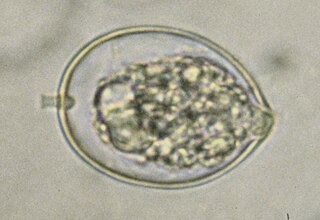
Phytophthora cactorum is a fungal-like plant pathogen belonging to the Oomycota phylum. It is the causal agent of root rot on rhododendron and many other species, as well as leather rot of strawberries.
Phytophthora nicotianae or black shank is an oomycete belonging to the order Peronosporales and family Peronosporaceae.
Pythium irregulare is a soil borne oomycete plant pathogen. Oomycetes, also known as "water molds", are fungal-like protists. They are fungal-like because of their similar life cycles, but differ in that the resting stage is diploid, they have coenocytic hyphae, a larger genome, cellulose in their cell walls instead of chitin, and contain zoospores and oospores.

Phytophthora erythroseptica—also known as pink rot along with several other species of Phytophthora—is a plant pathogen. It infects potatoes causing their tubers to turn pink and damages leaves. It also infects tulips (Tulipa) damaging their leaves and shoots.
Sclerophthora macrospora is a protist plant pathogen of the class Oomycota. It causes downy mildew on a vast number of cereal crops including oats, rice, maize, and wheat as well as varieties of turf grass. The common names of the diseases associated with Sclerophthora macrospora include “crazy top disease” on maize and yellow tuft disease on turf grass. The disease is present all over the world, but it is especially persistent in Europe.

Albugo is a genus of plant-parasitic oomycetes. Those are not true fungi (Eumycota), although many discussions of this organism still treat it as a fungus. The taxonomy of this genus is incomplete, but several species are plant pathogens. Albugo is one of three genera currently described in the family Albuginaceae, the taxonomy of many species is still in flux.

Bremia lactucae is a plant pathogen. This microorganism causes a disease of lettuce denominated as downy mildew. Some other strains can be found on 36 genera of Asteraceae including Senecio and Sonchus. Experiments using sporangia from hosts do not infect lettuce and it is concluded that the fungus exists as a quantity of host-specific strains. Wild species, such as Lactuca serriola, or varieties of Lactuca can hold strains that infect lettuce, but these pathogens are not sufficiently common to seriously infect the plant.

Plasmopara viticola, the causal agent of grapevine downy mildew, is a heterothallic oomycete that overwinters as oospores in leaf litter and soil. In the spring, oospores germinate to produce macrosporangia, which under wet condition release zoospores. Zoospores are splashed by rain into the canopy, where they swim to and infect through stomata. After 7–10 days, yellow lesions appear on foliage. During favorable weather the lesions sporulate and new secondary infections occur.
Phytophthora fragariae is a fungus-like (oomycete) plant pathogen that causes red stele, otherwise known as Lanarkshire disease, in strawberries. Symptoms of red stele can include a red core in the roots, wilting of leaves, reduced flowering, stunting, and bitter fruit. The pathogen is spread via zoospores swimming through water present in the soil, released from sporangia.
Phytophthora megakarya is an oomycete plant pathogen that causes black pod disease in cocoa trees in west and central Africa. This pathogen can cause detrimental loss of yield in the economically important cocoa industry, worth approximately $70 billion annually. It can damage any part of the tree, causing total yield losses which can easily reach 20-25%. A mixture of chemical and cultural controls, as well as choosing resistant plant varieties, are often necessary to control this pathogen.
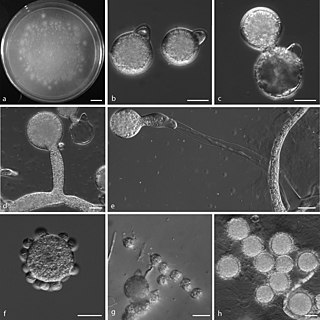
Conidiobolus coronatus is a saprotrophic fungus, first described by Costantin in 1897 as Boudierella coronata. Though this fungus has also been known by the name Entomophthora coronata, the correct name is Conidiobolus coronatus. C. coronatus is able to infect humans and animals, and the first human infection with C. coronatus was reported in Jamaica in 1965.

Synchytrium is a large genus of plant pathogens within the phylum Chytridiomycota. Species are commonly known as false rust or wart disease. Approximately 200 species are described, and all are obligate parasites of angiosperms, ferns, or mosses. Early species were mistakenly classified among the higher fungi because of their superficial similarity to the rust fungi. Anton de Bary and Mikhail S. Woronin recognized the true nature of these fungi and established the genus to accommodate Synchytrium taraxaci, which grows on dandelions, and S. succisae, which grows on Succisa pratensis. Synchytrium taraxaci is the type of the genus. The genus has been divided into 6 subgenera based on differences in life cycles.

Synchytriaceae is a chytrid fungus family in the division Chytridiomycota. The family was described by German mycologist Joseph Schröter in 1892. The type genus, Synchytrium, contains about 200 species of fungi that are parasitic on flowering plants, ferns, mosses, and algae. Synchytrium endobioticum causes potato wart disease, an economically important disease of cultivated potato.

Physoderma is a genus of chytrid fungi. Described by German botanist Karl Friedrich Wilhelm Wallroth in 1833, the genus contains some species that are parasitic on vascular plants, including P. alfalfae and P. maydis, causative agents of crown wart of alfalfa and brown spot of corn, respectively. Of the chytrid genera, Physoderma is the oldest. However, species were confused with the rust fungi, the genus Synchytrium, and the genus Protomyces of Ascomycota. Members of Physoderma are obligate parasites of pteridophytes and angiosperms. There are approximately 80 species within this genus.
Black rot on orchids is caused by Pythium and Phytophthora species. Black rot targets a variety of orchids but Cattleya orchids are especially susceptible. Pythium ultimum and Phytophthora cactorum are known to cause black rot in orchids.
